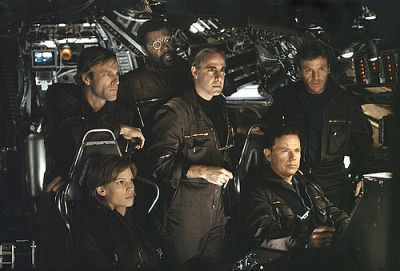




|
9 out of 10 |
 |
|
Has anyone ever heard of the Van Allen belts? Are they the ones on sale at Walmart this week? No? Well, therein lies "The Core" of the problem with this movie. To the average Jean-Guy on the number 67 bus to the Promenades De L'Outaouais, the idea of a big slab of rock the size of Texas coming down on him as in "Armageddon" seems like and obvious threat, but the shutdown of the earth's magnetic fields and exposure to weird electromagnetic particles from space is too estoteric to class it as asnything but pretentious mumbo jumbo. Couple this with the fact that the earth's core that acts as a giant dynamo could not in reality stop turning and stay halted, as it would be like trying to remain parked in the fast lane of Highway 417 and you have a film that is panned by intellectuals and the uninformed alike.
A feature film, though, requires by definition the suspension of belief - something that the audience pays to see that is made up, and as Science Fiction, this is truly superb. Requiring little more that this basic premisis of the core ceasing to rotate, Director Jon Amiel's movie provides the public with a journey that is well researched and as close to factual documentary as is possible. At the start, for instance, the crazed pigeons attacking the public in Trafalgar Square in London as a symptom of the shutdown of the rotation of the core is not necessarily a ludirous fantasy. In China, for instance, sudden mass migration of birds is carefully monitored as a warning of earthquakes as birds have been found to pick up ultrasonic sounds of fracturing and failing crustal rock that man cannot hear. To save the planet, the US Government sends a group of scientists to the centre of the Earth to "boost" it like a dead battery. Unlike "Armageddon: where the heros reach the Moon in minutes (it's actually a several day ride) and circle it in seconds, the scientists onboard their "Virgil " pass through accurately thicknesses, pressures and temperatures of the various layers of crust, mantle etc in appropriate times. In reality, of course, such a ship does not exist, yet criticism of the film on this ground is also totally unfounded. If you had told your grandm in 1960 that a trip to the Moon would give her pot that don't stick to food, she'd have laughed in your face, but within 10 years, every kitchen in the country had Teflon frying pans that NASA's Apollo programme had developed for flight to our only planet's natural satelite. Likewise, although no-one has developed the Engineer Ed Brazzelton's (Delroy Lindo) "Unobtainium" which gets more heat and pressure resistant the hotter and more pressured it becomes, there is no reason why such a product might not be one day developed. Indeed, some scientists have pondered the possible "island of stability" in the periodic table, a group of elements with such collossal atomic number and weight, well beyond that of Uranium, that they might be not only stable isotopes, but could have special and bizarre strengths and features. Similarly, criticism that it's hyper-fast drilling technique of using a combination oflaser-assisted ultrasonics is not feasible is not only unjustified, but just plain WRONG. The French Government, notorious for it's obsession with developing ludicrous, and useless weapon systems, developed an "ultrasonic", silent gun that could crush a man over 30 years ago and with the right frequency, such a drilling technique might be somewhat cumbersome and hideously costly, but could be nonetheless fully feasible.
Backing the scientists up above ground, the US has brought in a computer hacker, Taz Finch or "The Rat", played gloriously by rubber-faced DJ Qualls (best known for his title role in "The New Guy"), to "hack the planet". Yet the grip of the film remains the interaction of the scientists onboard the "Virgil", a team led by Major Rebecca Childs (Hillary Swank), a pilot whose space is in difficulties at the start of the film, precisely because of the developing electronic choas which the the failing magnetic fields cause. Whilst her crashlanding was sadly well hackneyed, not least of which as she has to come down in midtown LA, where 95% of Sci Fi is set these days to save of the pennies, it is nonetheless thrilling as she glides in on manual with no functioning computer. With her on her next mission to the Earth's core are Dr Josh Keys (Aaron Eckhart) who is first to discover the shutdown and Dr Serge Leveque (Tchcky Karyo, Hollywood's standard, off-the-shelf, hardbitten Frenchman). It is the presence of Stanley Tucci as Dr Conrad Zimsky, however, who truly brings the film to life. Unlike the standard image Hollywood image of a scientist as some hairbrained clown who is so obseesed with his formula that he can't even remember to tie up his shoelaces, Tucci creates a stunningly realistic portrail of a leading member of the scientific establishment. Many of those who lead research are often not there "for the betterment of mankind", but simply there for their own glory, stealing ideas from others to hit the headlines and dismissing critics contemptuously, yet still possessing enough intellect to keep the show on the road. Tucci's Zimsky is just such a person, driven by vanity and self-interest, he is a constant pain in the team's side, yet, when overwhelmed by briliance and logic, he is only too happy to throw the brilliance of his mind behind an idea and solve whatever problem they have. Unlike the classic movie "bad guy", he has no "evil intent", just an obseesion with his own persona and his place in history, and indeed, his presence gives another entire dimension, like that of Darth Vader in Star Wars, the redemption of Zimsky's soul.
Film Critic:
Robert L Thompsett |
|